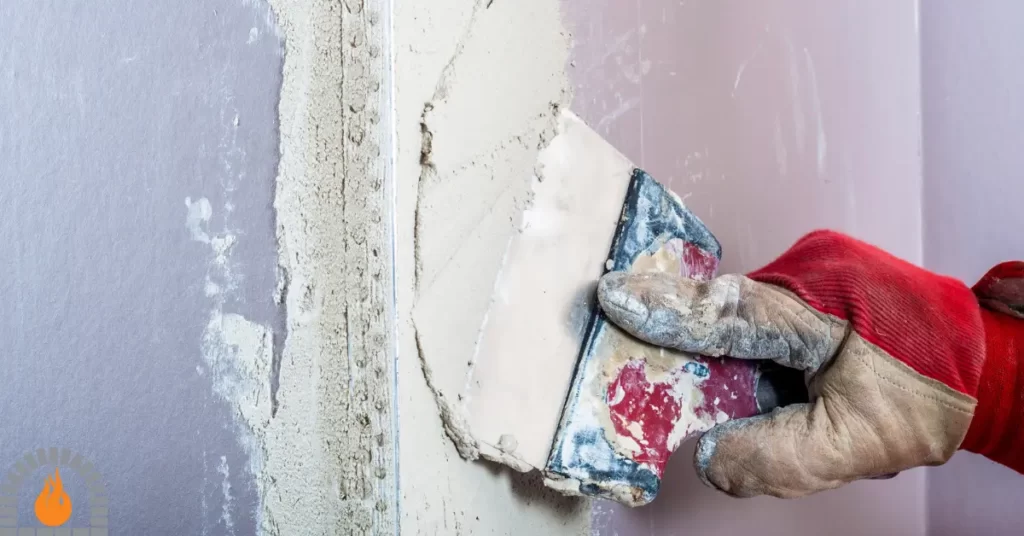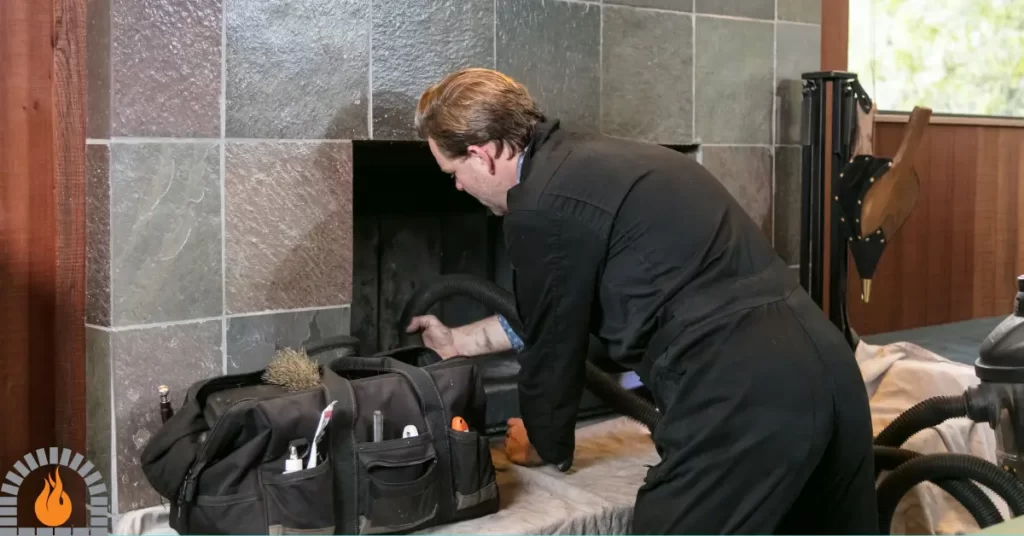A crack in fireplace can send shivers down your spine from the cold draft and the worry it sparks about your home’s safety and warmth. Fireplaces have long been a source of comfort and a gathering spot for families.
A simple solution for addressing a minor crack in your fireplace involves applying fire cement directly over the affected area. However, the best course of action for more extensive damage characterized by larger cracks is to replace the panels entirely. In instances where cracks appear in the mortar joints, a recommended approach is to carefully fill these gaps using mortar to restore the structural integrity of the fireplace.
This comprehensive guide delves into the causes behind a crack in the fireplace, explores repair options, and provides valuable tips for maintaining your fireplace’s integrity.
Understanding the Different Types of Cracks
Cracks in fireplaces can take various forms, each with its own set of implications. These may include surface cracks, which are minor and often cosmetic, or structural cracks that demand immediate attention.
Distinguishing between the two is crucial for accurate assessment and effective solutions.
Common Causes of Fireplace Cracks
A crack in your fireplace may be a symptom of underlying issues. Factors like extreme temperature changes, settling of the foundation, poor construction, or improper maintenance can all contribute to crack formation.
Recognizing the underlying cause is the initial stride toward discovering a sustainable resolution.

Types of Fireplaces Prone to Cracking
Disparities exist among fireplaces regarding their vulnerability to cracking. Traditional masonry, prefabricated, and gas fireplaces exhibit distinct attributes that can impact the occurrence of cracks.
Gaining insight into these distinctions can assist you in customizing your preventive measures.
DIY Assessment and Safety Measures
Before you call in the experts, there are some initial steps you can take to assess the severity of the crack and ensure your safety.
From checking for smoke leakage to examining the chimney’s exterior, these measures will help you gauge the situation’s urgency.
How To Fix Crack In Fireplace?
Fixing a crack in a fireplace involves some careful steps to ensure the safety and longevity of your fireplace. Here’s a general guide on how to address a crack in a fireplace:
Materials you might need:
-
Fireplace mortar or refractory cement
-
Wire brush
-
Vacuum cleaner
-
Protective gloves
-
Safety goggles
Steps:
-
Before starting, ensure your fireplace is completely cool. Please don safety gloves and protective eyewear to safeguard against potential risks.
-
Employ a wire brush to cleanse the compromised area meticulously. Eliminate any loose debris, soot, or ash from the crack’s surface to facilitate optimal adhesion of the repair material.
-
After brushing, use a vacuum cleaner with a nozzle attachment to clean up the remaining dust and debris. Make sure the area is clean and free of loose particles.
-
Follow the instructions on the fireplace mortar or refractory cement packaging to prepare the repair mixture. You must mix the powder with water to achieve a paste-like consistency. Use a clean container and a stirring tool.
Apply the Repair Material:
-
Carefully apply the prepared repair material to the crack with a trowel or putty knife.
-
Press the material firmly into the crack, ensuring it fills the gap.
-
Smooth the surface of the repair material to match the surrounding area.
-
Allow the repair material to cure according to the manufacturer’s instructions. This might involve letting air dry for a specified period or using a curing process recommended on the product packaging.
-
Once the repair is fully cured, you can lightly sand the surface if needed to achieve a smoother finish. Be cautious not to damage the repaired area.
-
Regularly inspect your fireplace for any new cracks or signs of wear. Keep the fireplace clean and well-maintained to prevent future issues.

Remember, safety is paramount when dealing with fireplaces. If you have any doubts or concerns, it’s always best to seek expert advice to ensure the integrity of your fireplace and the safety of your home.
The Back Wall of the Fireplace is Cracked: What to do?
The repair method will depend on the severity of the crack. Some possible solutions include:
-
Mortar Repair: If the crack is minor and doesn’t affect the structural integrity, a mason can patch it up using specialized fireplace mortar.
-
Fireplace Liner: A damaged or cracked back wall may require a new fireplace liner to ensure safety and proper functioning.
-
Reconstruction: If the crack is extensive and poses a safety risk, the back wall might need to be rebuilt or replaced entirely.
How To Fix Cracks In Brick Fireplace?
Repairing cracks in a brick fireplace can help restore its appearance and structural integrity. Here’s a step-by-step guide on how to fix cracks in a brick fireplace:
Materials Needed:
-
Safety gear (gloves, safety glasses, dust mask)
-
Wire brush or stiff bristle brush
-
Vacuum cleaner or shop vacuum
-
Masonry chisel and hammer
-
Mortar mix (matching the existing mortar)
-
Water
-
Mixing container
-
Pointing trowel
-
Paintbrush
-
Masonry sealer (optional)
Steps:
-
Use a wire or stiff bristle brush to clean the cracked area.
-
Remove any loose debris, dirt, and old mortar.
-
Vacuum the area thoroughly to ensure a clean surface.
-
Determine the size and depth of the crack. If the crack measures over 1/4 inch (0.6 cm) in width or indicates a potential structural concern, it’s advisable to seek guidance from a skilled mason or professional.
-
Mix the mortar according to the manufacturer’s instructions. Ensure you’re using mortar that matches the color and composition of the existing mortar in your fireplace.
-
Before applying mortar, dampen the crack with water using a paintbrush. This helps the mortar bond better.
-
Using a pointing trowel, carefully press the mortar into the crack, ensuring it fills the entire depth. Overfill the crack slightly.
-
Use the pointing trowel or a gloved finger to shape and smooth the mortar, matching the texture of the surrounding bricks. Remove excess mortar from the surface.
-
Allow the mortar to set for a little while, usually around 15-30 minutes. It should become firm but not fully dry.
-
Use a small piece of wood or a paintbrush handle to match the mortar’s texture with the surrounding bricks. This can involve creating a grooved or textured pattern.
-
After the mortar has fully dried (usually about 24 hours), you can apply a masonry sealer to protect the repaired area from moisture and staining.
Remember that larger or more serious cracks may indicate underlying structural issues that require professional attention. If you’re unsure about the severity of the crack or how to proceed, it’s best to consult a qualified mason or fireplace repair specialist.
You May Also Like To Read:
Professional Inspection and Repair Options
When faced with a significant or structural crack, seeking professional help is paramount.
Certified chimney inspectors can accurately assess the damage and recommend suitable repair options, from tuckpointing and sealant application to complete chimney reconstruction.
Preventive Maintenance for Crack-Free Fireplaces
As the saying goes, a little prevention goes a long way in avoiding the need for a hefty cure later on. Regular maintenance practices can significantly extend the life of your fireplace and reduce the likelihood of cracks.
From annual chimney cleanings to using the right type of firewood, incorporating these practices into your routine is essential.
Final Thoughts: Crack In Fireplace
A crack in your fireplace doesn’t have to spell disaster. By comprehending the root causes, adopting proactive strategies, and seeking expert advice, you can ensure that your hearth continues to radiate warmth and remain an inviting centerpiece for years.
Remember, a well-maintained fireplace brings comfort and adds value to your home. So, embrace these insights and keep the flames alive in your crack-free haven.
Affiliate Disclosure: Fireplaceadviser.com is a participant in the Amazon Services LLC Associates Program. We may earn a commission when you click on certain links on this site and purchase.

Hello!! I am Jamal Khan. I often fix my home electric heaters and gas stove problems and research the common issues in the heating units to improve my knowledge and expertise. The aim of establishing fireplaceadviser.com is to share my expertise and knowledge with my audience.












